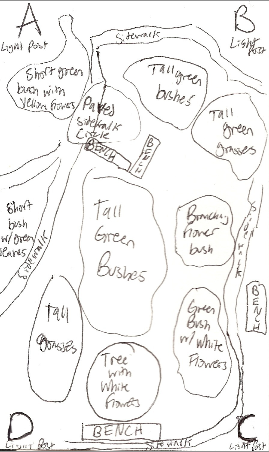User:Gabriel H Gan/Notebook/Biology 210 at AU
TA Alyssa Pederson MW 5:30-8:40PM 1 July 2014
Lab 1: Observing a Niche at AU
Introduction
The American University campus is saturated with different varieties of ecosystems. This lab notebook entry, the first in a series of three, will present and discuss observations from transect #3. Through this transect, it will be possible to study the biology of communities. The biodiversity, or number and type of species that live in an area, will be analyzed (Bentley 2014). In addition, living (biotic) and nonliving (abiotic) elements will be examined (Bentley 2014). Each species in the community has a niche that is important to the status of the community.
Transect #3 is located between Bender Arena, Hughes Hall, and the Woods-Brown Amphitheater. The coordinates are 38°56'16.2"N 77°05'20.4"W. The transect, approximately 20mx20m, has a collection of bushes, grasses, plants, and trees.
Figure 1: Map of Transect #3 Location on American University Campus

Transect #3 is located in between Bender Arena and Hughes Hall. Map from Google Maps.
Materials and Methods
Visual analysis was completed of transect #3. The transect was walked numerous times and observations on biotic and abiotic factors were recorded. A diagram of the plants and abiotic factors was sketched out. Photos were taken from an aerial view by standing on some of the benches. In addition to the photos taken from above, some were taken at standing height to record the survey of plants, trees and bushes.
Before leaving the transect, a soil and ground vegetation sample was taken. Back in the laboratory, this sample was mixed with Deer Park water and dried milk to make a hay infusion culture per lab manual instructions. The mixture was placed in an open jar and left out to be analyzed in the next lab.
Results
Below is a sketch diagram of the parts of the transect and numerous photographs. The transect is on flat, level ground with the exception of some small beds that are mound shape. In addition to the trees and plants noted, some small flying insects were present in the transect. The trees create a large amount of shady area.
Figure 2: Diagram of Biotic and Abiotic Components of Transect #3
- Note: Aerial photography was difficult due to tall nature of transect and inability to get to a place with a higher vantage point. Instead, multiple images were taken of the variety of elements in the transect.
Tables and Graphs
Table 1: Biotic and Abiotic Components of Transect 3
Discussion:
The purpose of this experiment was to explore the diversity in transcript #3. From initial observations, it appears that there are numerous types of plants and bushes present in the transect. It also appears that there are not many animals living in this transect. This may be due to the fact that the area is right next to the road and a busy part of campus that may not be conducive to undisturbed living.
The results of this initial exploration will be used to further the study of the many levels of organisms in the transect. By studying a small area with biodiversity, one can learn more about ecology.
References
Bentley, M., Walters-Conte, & Zeller, N.K. 2014. A Laboratory Manual to Accompany General Biology II. American University Department of Biology: Washington, D.C.
Lab 2: Identifying Algae and Protists
Introduction
The hay infusion jar from the previous lab period can be considered to be an ecosystem, composed of many microorganisms that each have different niches, or ecological roles (Bentley 2014). To identify organisms, a dichotomous key can be employed. This type of system presents series of two choices that can be used to narrow down the organism in question to a specific species (Bentley 2014). During this lab session, the dichotomous key was employed to determine what types of protists and algae were present in the hay infusion. In addition, a serial dilution was performed to prepare for the next lab session.
Materials and Methods
Before the hay infusion culture was examined, practice using the dichotomous key was obtained by identifying known organisms. After, the hay infusion culture jar was analyzed in terms of odor and appearance. Wet mounts were prepared of samples from both the niche in the top of the jar as well as at the bottom of the jar. Next, the wet mounts were examined under microscope and two organisms from the top of the jar sample and two from the bottom of the jar sample were identified. These organisms were sketched out and pertinent information was recorded. All procedures were completed per the Bio 210 lab manual.
After the hay infusion culture analysis, serial dilutions were performed in preparation for the microbiology lab. A 10^-2, 10^-4, 10^-6, and 10^-8 dilution was made and they were each spread on both a nutrient agar plate and a tetracycline plate. See below diagram of the serial dilution procedure.
Results
There was no strong odor coming from the jar with the hay infusion. The smell noted was similar to the odor present around most ponds. The water color observed was cloudy and a mild yellow-green tinge was noted. There was no apparent life on top of the liquid such as mold or green shoots.
In the top of the jar sample, green algae and blepharisma were observed. The sample from the bottom of the jar revealed chilomonas and colpidium. See Table 1 below for descriptions of each microorganism.
Tables and Graphs
Discussion:
References
Bentley, M., Walters-Conte, & Zeller, N.K. 2014. A Laboratory Manual to Accompany General Biology II. American University Department of Biology: Washington, D.C.



